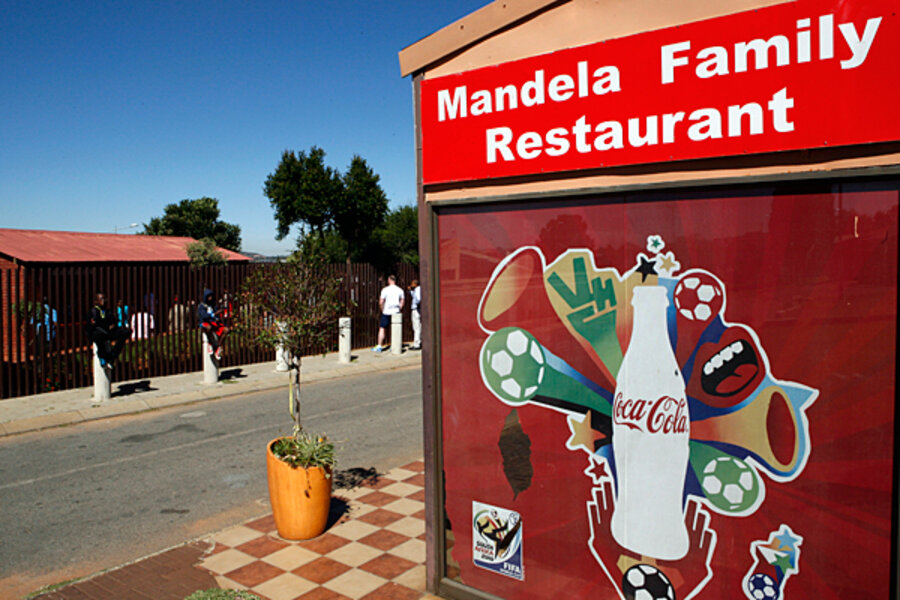Mandela's old street in Soweto now scene of new South Africa
Loading...
| Soweto, South Africa
Soweto is South Africa's most famous black township, the center of the anti-apartheid effort, and a key to the start of real democracy in this country.
Situated some 20 miles outside of Johannesburg, Soweto witnessed some of the most momentous struggles and uprisings against the apartheid system. The luminaries who resided in Soweto reads like a who's who of black South Africa: Desmond Tutu, Frank Chikane, and South Africa's first citizen, Nelson Mandela.
Coursing through Soweto is Vilikazi Street, where Mr. Mandela made his home 60 years ago. The street, which used to be filled with tension and often grief as well as protest, is now a tidy, successful tourist destination. There is a Mandela museum, surrounded by hawkers and various performing artists. The iconic street has become a place of restaurants and is pointed to as a path to prosperity in modern day South Africa -- though the unemployment and crime that plague the old South Africa are still here.
Vilikazi of course is well maintained. The city keeps the streetlights clean and lit, and there are none of the broken curbs, litter, and potholes that often seem to define other townships.
Thulani Mbokazi, manager of a restaurant-bar called The Shack Shebeen says the immediate area used to have crime problems and was not safe and well-maintained.
“Now you can walk always on Vilikazi street and there would be nothing wrong,” Mbokazi said.
The success of Vilikazi runs roughly parallel with that of Soweto. As apartheid disappeared, the city pushed growth in small businesses, tourism, bars, and the construction of a massive Maponya Mall -- said to be the largest in South Africa.
Jonathan Ramotsei, manager and on-air host for Soweto TV, said the mall and environs are an outgrowth of the town's pride although he also mentions a somewhat smug attitude as well.
“Soweto has progressed rapidly. We've had embedded in us the notion that we're better than other townships,” Mr. Ramotsei says with a laugh.
“[We] always have to come with something better.”
But its not only tourists in search of history who are visiting Soweto. There's a real nightlife that draws many of the young and newly moneyed to Soweto's clubs and bars.
Farai Tandy is the co-owner of one of Soweto's oldest nightspots, Club Pelican. While many of the young and beautiful used to party in Johannesburg, that's no longer the case.
“The party scene in Soweto is pretty good ... I think a lot of people don't need to go to Joburg to party because we have a lot of places to go to,” Mr. Tandy said.
After clubs close for the night, revelers head for street food stands that line the long roads selling dumplings, steak, chicken feet, and scopa or sheep's head.
Soweto has not been spared the problems plaguing the rest of South Africa. While Vilikazi street may be safe, some areas of the township away from Vilikazi – Mbokazi calls “deep Soweto” – continues to suffer from crime, unemployment and a lack of services.
The success of Orlando, the most famous area of Soweto which includes Vilikazi street, has also bred resentment among poorer residents.
“They call us 'bourgeois',” Mbokazi said.
Only a few minutes from the clean streets and good times of Vilikazi is Nomzamo Park, an informal settlement. Nomzamo's streets are mostly unpaved and pitted. There are some houses but most of the structures are shacks with corrugated iron walls and metal roofs held down by rocks. Every few houses there are clusters of concrete outhouses.
While success is geographically close, it feels far away from the unemployed of Nomzamo Park.
Informal settlment resident Siyabonga Majija came to Soweto looking for work, like many of the hundreds of thousands who have flocked to South Africa's cities in search of a better life.
Majija hasn't been able to find steady work in the 10 years since he arrived from Eastern Cape, one of South Africa's poorer provinces. He spends his time sitting and chatting with his brothers by the side of the road.
“It's very bad. I can't find a job. Any job,” Mr. Majija says as his brothers nod in agreement.
He says his life in Soweto has been hard due to a lack of work. Majija now wishes he never left Eastern Cape. Soweto – a place that has meant success for many – does not feel like his home.





